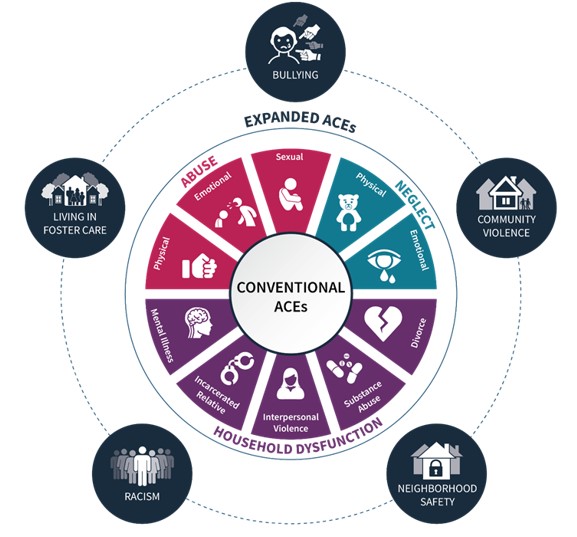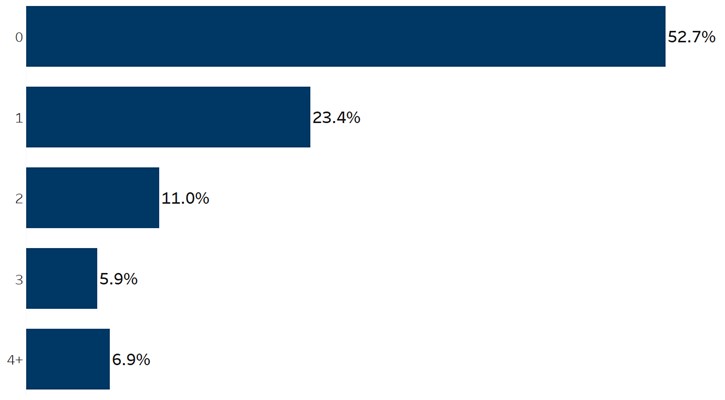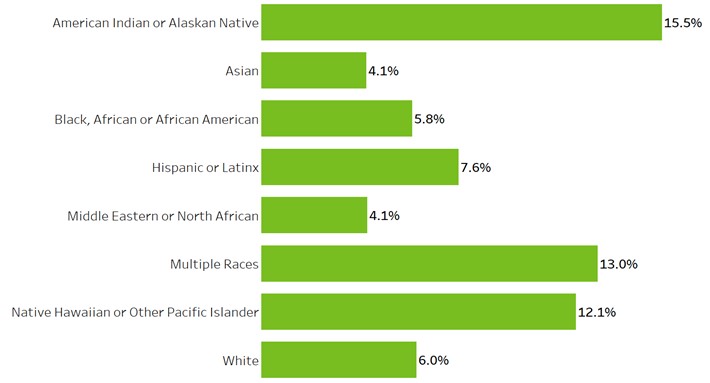Adverse Childhood Experiences (ACE) in Minnesota
Contact Info
Adverse Childhood Experiences (ACEs) Basics
Children are shaped by their earliest experiences and relationships at home, at school, and in their neighborhoods. Adverse Childhood Experiences (ACEs) are stressful events in a child’s life that occur before they turn 18 that can potentially impact their health and well-being. ACEs include things that happen at home or in community that can cause or contribute to the pile-up of stress that overwhelms a child’s ability to cope. Experiencing ACEs is the result of systems and social conditions, not individual actions. As public health research and knowledge of how much the environment outside of the home can influence a child’s well-being has expanded, the original list of ten conventional ACEs has been expanded to include five additional ACEs representative of community and societal impacts on health (See Figure 1). Researchers and practitioners have agreed upon the list of fifteen ACEs in Figure 1, although there are many other potentially stressful events that can impact a child’s well-being and health outcomes. ACEs include experiences such as:
- Abuse – physical, emotional, or sexual.
- Neglect – physical or emotional.
- Household challenges, like financial hardship or living with someone who misuses drugs or alcohol.
- Living with a parents or caregiver with severe mental health challenges.
- Discrimination.
- Feeling unsafe in their neighborhood.
- Bullying.
- Witnessing violence.

The likelihood of experiencing ACEs is influenced by social conditions that impact a child’s or their caregivers’ ability to cope with stress, such as discrimination, poverty, and limited education or employment opportunities. These in turn are often the result of racism, historical trauma, and unfair social conditions that prevent everyone from having the same opportunities. These social conditions that have an impact on a child’s life are called the social determinants of health. More information about the connection between ACEs and social determinants of health can be found on our ACEs and SDOH web page.
Why do ACEs matter?
Children who experience ACEs often have a higher level of stress than children who do not experience ACEs. High levels of stress can lead to serious health problems in adolescence and throughout adulthood like depression, diabetes, and heart disease as well as an increased likelihood of engaging in high-risk behaviors such as misusing drugs like tobacco and alcohol. The impacts of ACEs sometimes do not show up until many years later. The more ACEs a person has, the greater the risk of experiencing health problems and challenges in school, work, and relationships. For example, the risk for anxiety, depression, and smoking increases as the numbers of ACEs increases. Minnesotans with more ACEs are more likely to rate themselves as having fair or poor health as compared to those with no ACEs.
- The risk for anxiety, depression, and smoking increases as the numbers of ACEs increases.
- There is also a clear increase in reported chronic drinking for Minnesotans with four or more ACEs.
- The correlation between ACEs and obesity or diabetes is not as evident among Minnesotans.
- While there is a definite increased risk of asthma for Minnesotans with five or more ACEs, there is no clear pattern for those with four or fewer ACEs.
- Minnesotans with more ACEs are more likely to rate themselves as having fair or poor health as compared to those with no ACEs
- ACEs can be prevented and not all children who experience an ACE will have health problems. While not every child will experience negative impacts of ACEs, there are ways to make it less likely they will be negatively impacted, for example ensuring that all children have supportive connections to parents and caring adults in the community. These are called protective factors and help children cope with stress from challenges. Protective factors can be promoted in families, schools, and communities.
ACEs are common?
Among American adults, it is estimated that 1 in 6 adults experienced at least one ACE during childhood and 1 in 5 have experienced three or more ACEs. Although ACEs are common, they are not experienced equally across demographic groups. Children from communities that have experienced structural racism and other injustices tend to report more ACEs. In the United States, 61% of Black children and 51% of Hispanic children have experienced an ACE compared to 40% of white children. The higher occurrence of ACEs among children of color is not because of a single child or family’s actions, rather this is due to inequalities influenced/impacted/driven by social determinants of health.
In Minnesota, we measure ACEs and protective factors most commonly through two different survey tools—MSS and BRFSS.
In 2022, 47% of Minnesota students have reported experiencing at least one ACE. Just over half of Minnesota students report not experiencing any ACEs.
Most Minnesota students reported that they haven't experienced any ACEs.

Source: 2022 Minnesota Student Survey
Among Minnesota students that report experienced one or more ACE, children from communities that have experienced structural racism and other injustice tend to report more ACEs. American Indian/Alaska Native children living in Minnesota have the highest prevalence of four or more ACEs (15.5%) followed by children who identify with multiple races (13%).
Percentage of students with four or more ACEs in each race/ethnic group.

Source: 2022 Minnesota Student Survey